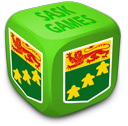Ah the joy of a truly intriguing game coming in a small package.
Welcome to 3D Pawn by designer George Smith.
This is a devilishly simple idea, at least in concept.
The 'board' is a cube with a three-by-three grid on each side.
A two-player game, each combatant starts with nine pieces on opposite of the cube. They are held in place by surprisingly strong magnets which allows the pieces to move around the cube and stay in place.
The pawns move one forward or sideways but not backwards. If a pawn is on its starting side, it can move two squares in the same direction. So they have the general feel of a chess pawn.
A pawn can take a piece diagonally in front of it, moving into its place.
The goal of the game is equally simple, although not so easily achieved. To win: get your piece onto your opponent's side without being instantly taken.
The key to the basic game is the experience of having to comprehend the game in three dimensions. There are only a few board games, Axiom coming to mind, which have game play in three dimensions, and that makes 3D Pawn refreshingly different without overly complex rules to grasp.
Adding to this game in terms of being worth seeking out is the checkmate expansion.
"Instead of nine pawns, each player starts with eight pawns and a king in the middle," details the rules.
"Pawns move like in the basic version. When a pawn gets to the opposite side, it becomes a queen and the game continues.
"A queen moves any number of vacant squares in a horizontal, vertical or diagonal direction. She takes pieces in the same way. A queen can move across but not "along" edges. The queen in the diagram can't move to the opposite side and has no legal move.
"The king can move to any square around him. He takes in the same way. A king is in check when it is under attack of an enemy piece. A player may not make a move which places or leaves their king in check."
As in chess "to win, you must checkmate your opponent. This occurs when their king is in check and there is no legal way to remove it from attack. Alternatively, your opponent can resign, which is a common way to end the game."
Made of wood, except for the magnet nodules, this game will look great on a desk, or book shelf, set on a small stand, where it can start a conversation and lead to a quick game, or two, and that is a nice plus.
The game is so compact, aesthetically pleasing, easily learned, yet mind-bending, that it really deserves the highest recommendation.
Welcome to 3D Pawn by designer George Smith.
This is a devilishly simple idea, at least in concept.
The 'board' is a cube with a three-by-three grid on each side.
A two-player game, each combatant starts with nine pieces on opposite of the cube. They are held in place by surprisingly strong magnets which allows the pieces to move around the cube and stay in place.
The pawns move one forward or sideways but not backwards. If a pawn is on its starting side, it can move two squares in the same direction. So they have the general feel of a chess pawn.
A pawn can take a piece diagonally in front of it, moving into its place.
The goal of the game is equally simple, although not so easily achieved. To win: get your piece onto your opponent's side without being instantly taken.
The key to the basic game is the experience of having to comprehend the game in three dimensions. There are only a few board games, Axiom coming to mind, which have game play in three dimensions, and that makes 3D Pawn refreshingly different without overly complex rules to grasp.
Adding to this game in terms of being worth seeking out is the checkmate expansion.
"Instead of nine pawns, each player starts with eight pawns and a king in the middle," details the rules.
"Pawns move like in the basic version. When a pawn gets to the opposite side, it becomes a queen and the game continues.
"A queen moves any number of vacant squares in a horizontal, vertical or diagonal direction. She takes pieces in the same way. A queen can move across but not "along" edges. The queen in the diagram can't move to the opposite side and has no legal move.
"The king can move to any square around him. He takes in the same way. A king is in check when it is under attack of an enemy piece. A player may not make a move which places or leaves their king in check."
As in chess "to win, you must checkmate your opponent. This occurs when their king is in check and there is no legal way to remove it from attack. Alternatively, your opponent can resign, which is a common way to end the game."
Made of wood, except for the magnet nodules, this game will look great on a desk, or book shelf, set on a small stand, where it can start a conversation and lead to a quick game, or two, and that is a nice plus.
The game is so compact, aesthetically pleasing, easily learned, yet mind-bending, that it really deserves the highest recommendation.
